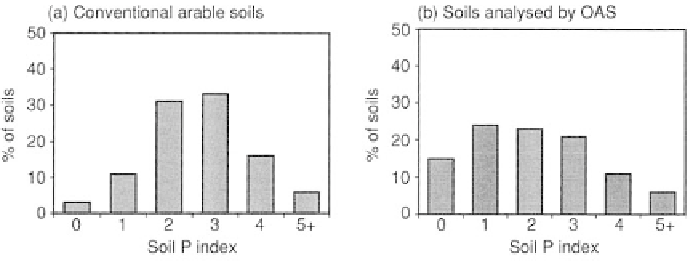Agriculture Reference
In-Depth Information
and a negative balance might indicate that the system is unsustainable. For
this study, three model organic farms have been derived, which represent
the breadth of organic systems in the UK: a typical upland/hill farm
with sheep and suckler beef, a lowland dairy farm and a stockless arable/
horticultural farm (Shepherd
et al
., 1999). Farm gate budgets for N, P and
K have been compiled from farm records, measurements and standard
tables of nutrient contents.
Results
Soil indices
Data from organic farms showed that 39% of soils were at a P index of 0 or
1, with 23% at index 2 (Fig. 4.8.1b). In conventional arable soils, only 14%
were recorded at a P index of 0 or 1 (Fig. 4.8.1a); while in grassland 40% of
soils were are at a P index of 0 or 1 (Skinner
et al
., 1992). In conventional
arable soils, 28% of the soils tested were at a K index of 0 or 1 and 48% of
grassland (Skinner
et al
., 1992). Double lactate extraction of P and K, as
part of the Balzer P extraction, showed that 86% of soils were deficient in
available P and 36% were deficient in available K.
Nutrient budgets
Tables 4.8.1, 4.8.2 and 4.8.3 display nutrient budgets for three model
organic farms (upland/hill farm, lowland dairy farm and stockless); to
aid comparison, all values are given in kg ha
−1
averaged over the whole
farm area. Animal feed and straw are major sources of P and K in the
livestock-based systems. In the stockless system, additions of compost are
the main source of P and K. In all the systems, symbiotic fixation of N by
leguminous plants is important. In the extensive upland system, deposition
Fig. 4.8.1.
Frequency distribution of the soil P index (MAFF, 1986).












Search WWH ::

Custom Search